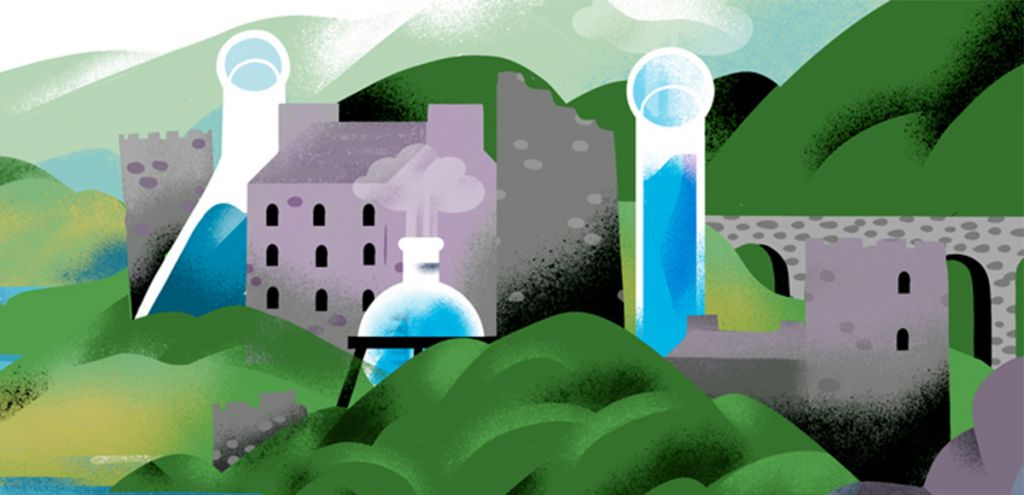There is a growing awareness of the waste and pollution caused by the building industry. New biomaterials are being created using waste products and microbes to solve these ecological problems.
“Using biological materials in buildings isn’t a new concept – we’ve built wooden structures for thousands of years,” said Gavin McIntyre, co-founder and Director of Business Development at Ecovative Design, a US-based biotech making materials with mycelium — part of the root system of mushrooms.
Increasing knowledge about microbiology and synthetic biology techniques is now allowing innovative biomaterials to enter the market, such as self-healing concrete, mycelium insulation, chipboard made of food waste, and artificial mother of pearl.
“What’s unique about the new generation of biomaterials is that they’re tunable. We can now build unique properties into materials at the molecular level,” said McIntyre.
Although there has been interest in developing new biomaterials for building for some time, the building industry is conservative and heavily price-driven, meaning acceptance has been slow. However, the increasing consumer demand for sustainability has heightened interest in these innovations, resulting in a more competitive environment for building materials.
“The building and construction industry needs disruption,” said Ginger Krieg Dosier, founder and CEO of Biomason, a US-based company that grows cement through a biological process with a low carbon footprint.
“Traditional Portland-based cement has not seen disruption in 200 years. Biological solutions provide a new way of manufacturing through understanding the blueprints found in nature as inspiration.”
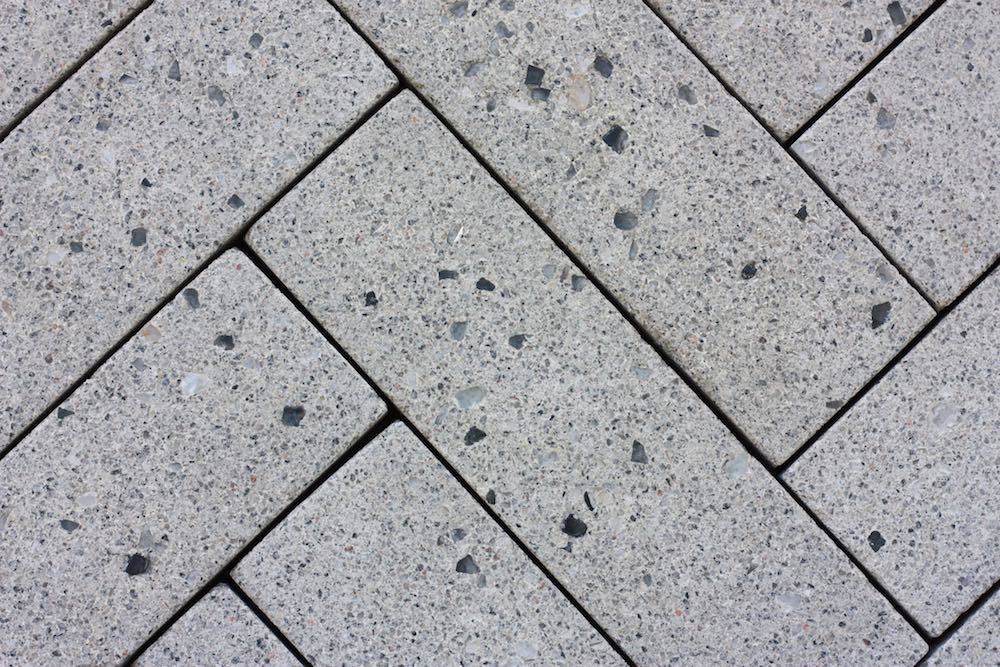
Living cement
Concrete is one of the most widely used building materials in the world. In one form or another, it has been around since ancient times. Concrete is formed by combining fine and coarse particles of materials like limestone and sand — known as aggregate — with a binding material such as cement.
Portland cement, named after the stone from the Isle of Portland in Dorset, UK, was invented by Joseph Aspdin and patented in 1824. Made from finely ground and heated limestone and clay minerals combined with gypsum, a component of plaster, it is still the most widely used form of cement today.
A big problem with the manufacture of cement is that it is highly polluting and produced in such abundance that it accounts for 8% of the annual carbon emissions around the world and uses around 10% of global drinking water, according to Dosier.
Concrete is generally quite a durable material, but over time it is subject to cracking, particularly in damp conditions, which can corrode the embedded steel reinforcement bars, especially in water-based structures. It is also subject to damage from extreme temperatures, chemicals, and weather erosion.
To counter some of these negative effects, several companies are harnessing the power of non-harmful, extremophile bacteria, such as Sporosarcina pasteurii and Bacillus pseudofirmus, to effectively create self-healing concrete. These tough bacteria occur naturally in extremely alkaline lakes near volcanoes and produce their own limestone. Their spores can live for 200 years and withstand temperatures above 200℃.
Delft University microbiologist Hendrik Jonkers decided to experiment with adding these bacteria to a standard concrete mix to make it more stable. This led to the formation of the Dutch company Green Basilisk in 2015 to take this product to market.
Their product, called Basilisk, is an addition to normal concrete that contains bacterial spores. When they are exposed to water, the bacteria start to grow and produce limestone, which stabilizes the structure, reduces shrinkage, and makes it more watertight.
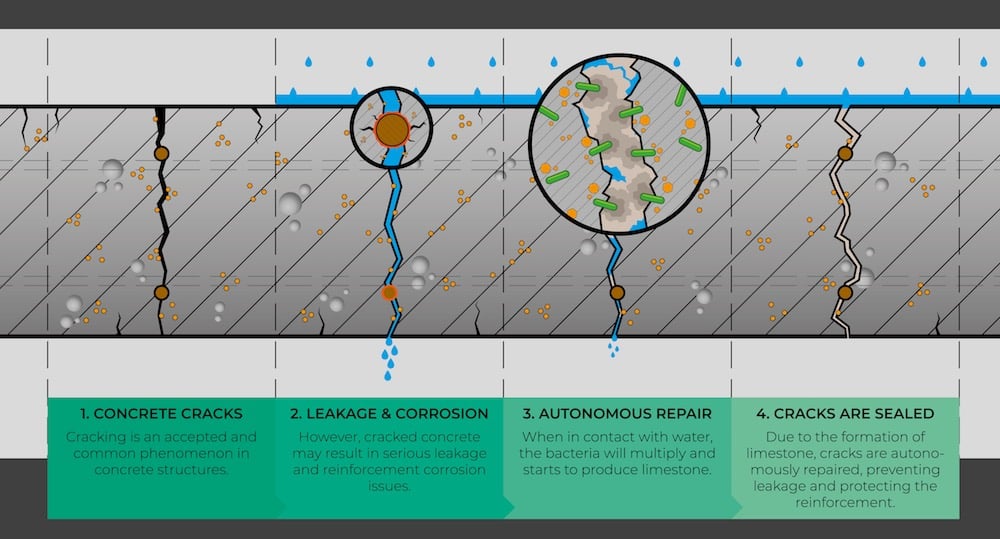
“We can reduce shrinkage reinforcements by up to 50%. That would mean if we just add five kilos of Basilisk into the concrete mix we can save up to 30 kilos of fuel per cubic meter,” said Marc Brants, marketing and accounts manager at the firm.
It took some time for Green Basilisk to achieve certification, but Brants said it is now getting a lot of interest from companies and organizations wanting to use its biomaterials.
“Governmental companies are really pushing the contractors to use greener solutions. We see that they are really looking for these kinds of innovations and we see it in [the growth of] our inquiries.”
Biomason uses similar microbes to Green Basilisk, but has a different process. The company mixes a solution containing urea, calcium chloride, and bacteria with waste aggregate and forms it into molded tiles, which then cure to full strength in ambient temperatures. This removes the need for high temperatures and fossil fuels during the production process.
“I established the company after forming the idea to ‘grow a concrete brick’ inspired by how coral reefs and natural marine cements are formed. Trained formally as an architect, my approach was to use design thinking, brute force, and iteration,” says Dosier.
Wil Srubar is an associate professor focusing on architecture and new materials at the University of Colorado Boulder, US, as well as director of advanced materials at the US-based construction firm Katerra. He and his team are working to improve the sustainability and durability of concrete using microbes.
To achieve this, they are using photosynthesizing Synechococcus cyanobacteria, a unicellular organism found widely in marine environments. When embedded in a hydrogel and sand scaffold mold, the bacteria begin to absorb carbon dioxide and light to fill the mold with a concrete-like structure.
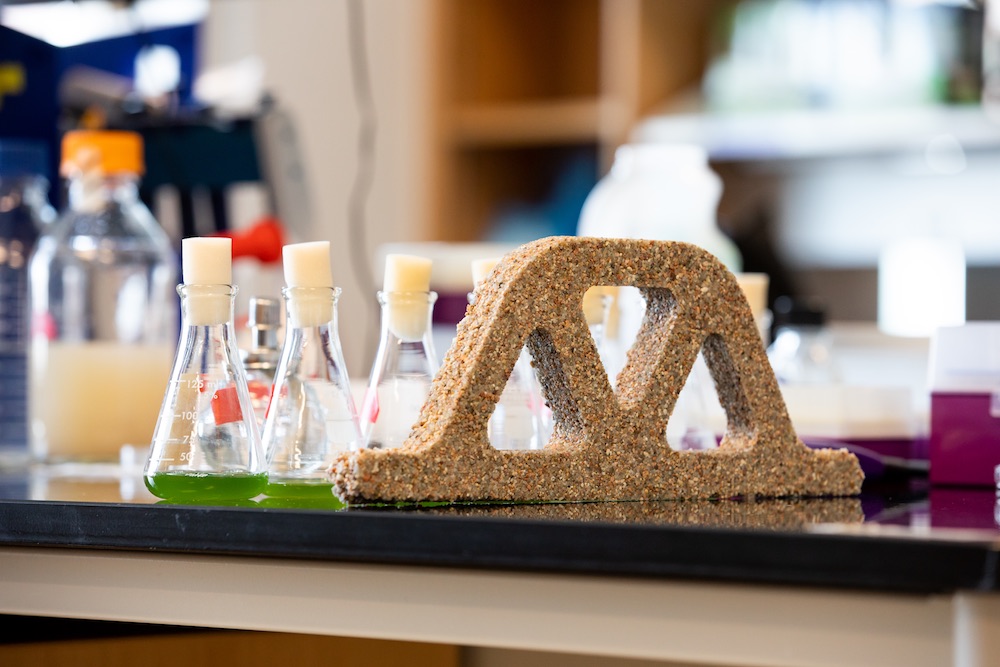
“We use tools of synthetic biology to improve mineralization … and to help improve the resilience of the organisms to survive desiccated conditions,” Srubar explained.
“Our material could be used as a building block for many applications, including carbon-sequestering mortar, lightweight concrete in buildings, biologically active surfaces, temporary disaster-relief shelters, or roadways.”
When the bricks dry out, the bacteria go into a stasis mode, but can become active again when exposed to warmth and humidity. Theoretically, it is possible to cut a brick in half and grow two new bricks by immersing each half into a solution of the raw biomaterials.
“We believe this material is particularly suitable in resource-scarce environments, such as deserts or the Arctic—even human settlements on other planets,” noted Srubar, who has recently spun out a startup called Prometheus Materials to develop these innovative biomaterials further.
Magic mushrooms
Another promising construction material is mycelium, which forms part of the root structure of mushrooms. That is the focus of Biohm, a UK-based startup that develops sustainable and biodegradable materials for the construction industry.
“We want to be as resource-efficient as possible,” said Aaron Jones, development manager at the company. “Our technologies are focused on utilizing waste products from agricultural industries or construction industries, and trying to regenerate these materials and make them useful.”
The company’s lead product is a mycelium-based insulation panel, which is currently undergoing certification. A key advantage of mycelium is that it can be grown on waste agricultural products and is biodegradable. It also contains chitin, which is a natural fire retardant.
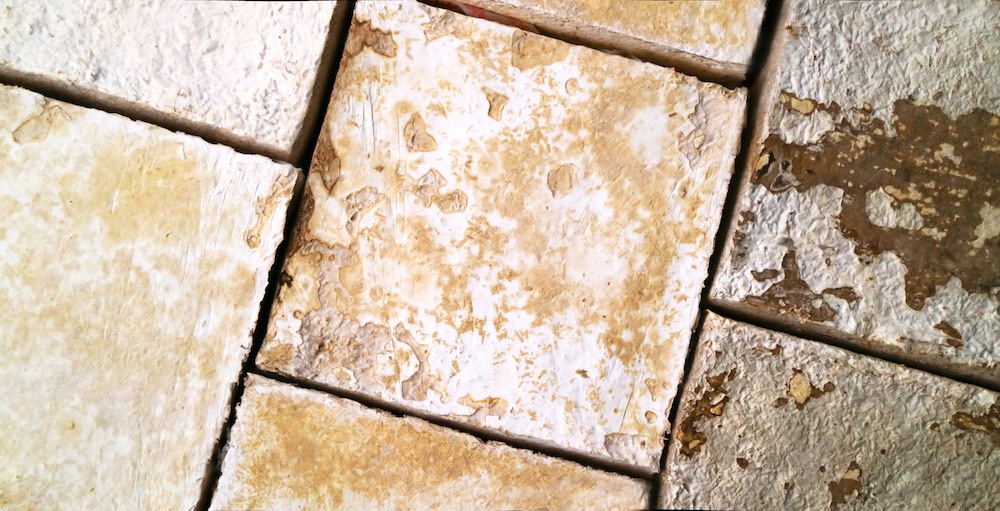
“If you look at insulation on the market at the moment, there is a wide range of options that are predominantly petrochemical materials. So they are plastic, in the broadest sense of the term, and at the end of their life they are going to end up in landfill,” explained Jones.
“What we’re looking at is building on this idea of circularity … if we were to take the material back, we could break it down and then put it back into the growth process when we grow the mycelium pane. This is something that we’re experimenting with as well.”
Another company creating biomaterials out of mycelium is US-based Ecovative Design. It is currently creating packaging by using mycelium to bind agricultural byproducts together, making mushroom leather and foam for a variety of uses, and has recently branched out to create meat substitutes using specialty mushrooms via a spinout called Atlast Food.
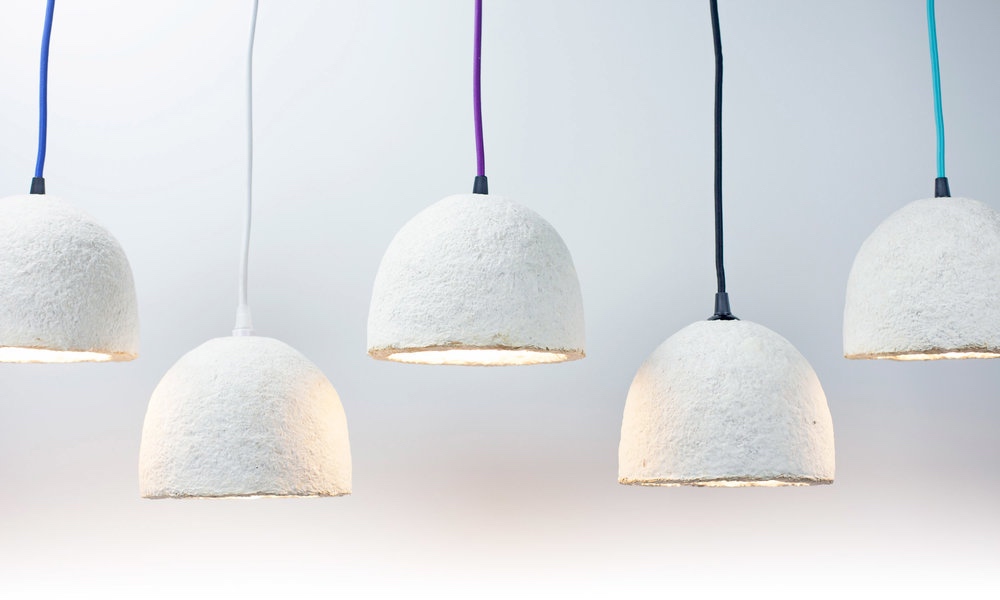
Notably, Ecovative was also developing insulation foam for the building industry, but has since moved away from this area for undisclosed reasons. This could be related to the lack of acceptance from the industry, something that Biohm is also dealing with.
“Within construction, just overcoming pre-existing biases and pre-existing notions of what an insulation panel is can be a challenge,” said Jones. “People ask a lot of questions like ‘will it start growing in my walls?’ ‘Will it start eating my house?’”
Biohm is also researching and developing new products, including making chipboard or medium-density fiberboard using food waste, such as orange peel.
“We’ve tested a few different things like coffee chaff, cocoa husk, and citrus peel… we don’t want the board itself to have a huge nutritional content because we don’t want it to be eaten by pests,” says Jones.
“Citrus peel is very firm and it gives the board a different texture… to make the sheet board as strong as possible and as competitive as possible to things like medium-density fiberboard.”
Bio buildings of the future
There are several challenges that need to be overcome before companies can sell biomaterials to the building industry. To start with, independent certification is required by most countries to comply with safety regulations. This can take considerable time and effort to achieve, depending on the country.
“It took about three to four years to get our products certified,” said Brants. “Especially for larger projects, contractors don’t want to get involved with innovations when they have to take on responsibility, so that was a very important first step. Now that we have our product certified we see some interesting growth in all kinds of market segments.”
Another issue is scaling up. It is generally much easier to make novel materials on a small scale and bridging the gap to large-scale production can be a challenge.
Communication is also key; a big problem in the building industry is getting consumers to accept innovative biomaterials. Pricing can be problematic too, as the construction industry is strongly driven by costs. If the new material is more expensive than what is already available it is unlikely to be purchased.
Brants said Green Basilisk is approaching this challenge by making a case for the longevity of the product. “With the self-healing technology, you ensure a longer shelf life, less maintenance. So, for the end user, it’s already a break even. But we also want to create a business case for the contractor… by leaving out watertight membranes or special coatings and reducing steel, we can end up with a business case,” he emphasized.
Srubar said that one of the advantages of the material he has created with his team is the price point, which they have designed to directly compete with normal concrete. “[Sustainable building] materials must be cost-competitive with traditional materials, since construction is a commodity market,” he explained.
Despite these challenges, the worldwide conversation about global warming and pollution has made many people realize the importance of making industries greener and more sustainable.
This is already having a positive effect on companies working in the construction industry, as the organizations behind large building projects want them to be greener and more sustainable.
“There’s a realization that if we don’t move towards a more sustainable business and a circular economy in the next 10 to 20 years, then we’re going to be producing more waste, and landfills are going to be filled up quicker and quicker,” said Jones. “This is an issue, and practices and technologies like this are going to solve it.”




